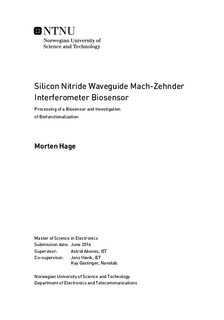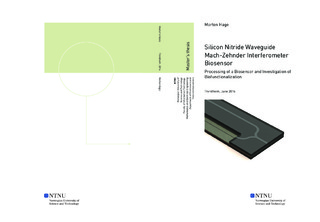| dc.description.abstract | The main part of the project is devoted to processing of a MZI waveguide structure using silicon on insulator technology which is carried out at the NTNU NanoLab. MZI is a common interferometry technique that suits bio-sensing applications due to its robustness and rigid sensing mechanism. The processing is based on previous simulations performed in the project thesis, and calculations using the effective index method in order to determine waveguide geometries yielding single-mode propagation.
This work includes silicon dioxide and silicon nitride deposition by plasma enhanced chemical vapor deposition (PECVD), characterized using refractometry and atomic force microscopy (AFM). A surface roughness of \SIlist{3.2;0.4}{\nano\meter} was achieved for the silicon dioxide and silicon nitride, respectively.
Electron beam lithography (EBL) with a newly installed Elionix EBL was used to pattern the waveguide structures on photoresist. Only a minor adjustment of the exposure dose was necessary in order to achieve satisfying results. However, tuning of the beam current and dot size could provide smoother structures and need to be addressed in order to optimize the waveguide profile.
Dry etching methods by inductively coupled plasma reactive ion etch (ICP-RIE) were used to process shallow rib waveguides in the silicon nitride. The RIE etch tested had a lower etch rate compared to the combined ICP-RIE etch, giving better etch control. The resulting wall roughness was however larger for the RIE etch, but optical transmission measurements are needed to investigate the influence of roughness on light propagation.
The sensor functionality depends strongly upon the biofunctionalization processes needed for the capture of analytes. Bio-sensing is very much limited by the biofunctionalization chemistry due to its critical function of analyte capture. The sensor surface is coated with antibodies which act as capture agents. The antibodies need to be selective to, and have high affinity towards, the analyte. These requirements are challenging to obtain and is one of the major limitations in the work towards high sensitivity biosensors. Due to this limitation, the issue is addressed with the goal of achieving increased understanding and experience in this field.
Amino-silane was used to generate a surface with primary amines on silicon nitride. Both vapor phase (VP) and liquid phase (LP) silanization were researched, and the methods was characterized using contact angle measurements and AFM. The VP method resulted in more uniformly silanized surface. Carbodiimide crosslinker chemistry was further used to conjugate and immobilize capture antibodies to the amines and fluorescence microscopy was used to characterize secondary antibody fluorescence conjugate that had bound to the primary antibodies. Low crosslinker concentration was found to yield the most uniform fluorescence with less aggregate formation. | |

